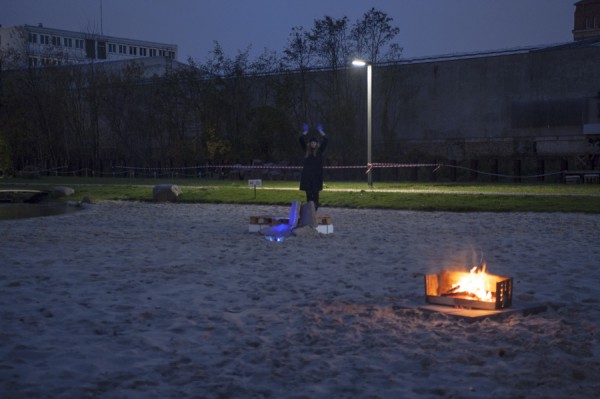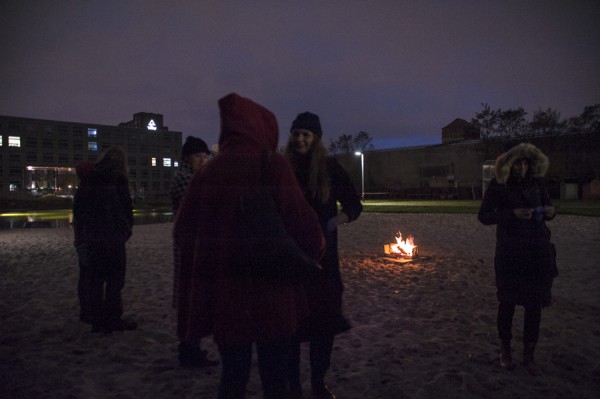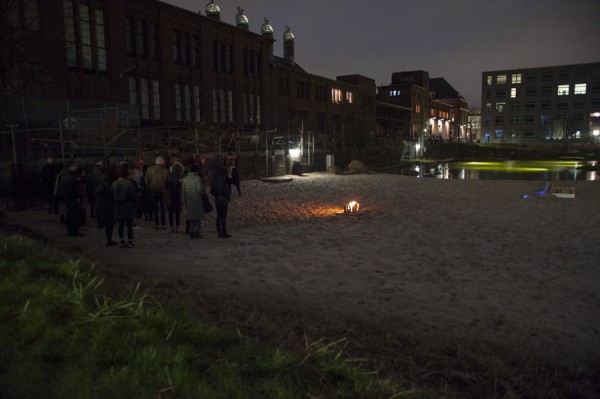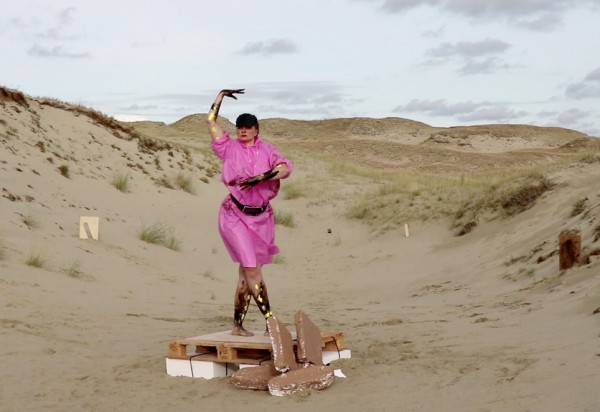
Bryndís Björnsdottír, Landráð II: Unearthing, Performance, District Berlin, 2017. Photo: Emma Haugh

Bryndís Björnsdottír, Landráð II: Unearthing, Performance, District Berlin, 2017. Photo: Emma Haugh

Bryndís Björnsdottír, Landráð II: Unearthing, Performance, District Berlin, 2017. Photo: Emma Haugh

Bryndís Björnsdóttir, Landráð II: Unearthing, Performance,Nida Art Colony 2017, Photo: Emma Haugh
Performance von Bryndís Björnsdóttir
18. November 2017, 16 h
Shit
Droppings
White dung, gold
Guano
Soil
Pure Guano
Shit
Guano rush
White gold
This is the story of the bird cormorant, the sea raven and its excrements, Guano.
For centuries Guano was known as an organic fertilizer in South America, used by the Inca’s, the “world” did not become aware of it until the German explorer Alexander von Humboldt sneezed.
I am told it happened on his trip in South America, soon after he climbed mountain Chimborazo in Ecuador, the highest mountain above earth’s center. On the Chimborazo mountaintop, which no Man had climbed before and reached such heights and breathed such thin air, Humboldt found his love of nature. He stood on the mountaintop and began to see the world differently, that everything is connected and that nature has to be experienced by feeling.
But it wasn’t until on the docks in Peru, where shipments of Guano where passing him by, that he sneezed. The powder of the white gold entered his body and called out for a natural reaction. As Humboldt sneezed, his scrotum contracted in a sudden spasm.
(Excerpt from Landráð II: Unearthing)
As an artist and The Many Headed Hydra companion in residency in Nida, Bryndís unearthed a tale about wellness tourism in exoticized landscapes by juxtaposing the sands of Iceland, Sahara and Nida as wastelands for projections. In District Bryndís aligns herself with a key figure in marking the reading of land in Nida beyond to the plastisphere: The story of the cormorant is a glimpse into the smelly and hot com-post realms of modernity or a Peter and the Wolf narration told with enhanced sensory organs.
Die Bergfrau (isl. Fjallkonan) ist ein nationalstaatliches Produkt. Als weibliche Personifizierung Islands hat sie ihre Wurzeln in der alten indogermanischen Mythologie und soll die Natur als einen undurchdringlichen nationalen Körper symbolisieren, wobei das die Insel umgebende Meer ihren Keuschheitsgürtel darstellt. Eine mythische, in den Köpfen männlicher Dichter des 19. Jahrhunderts entsprungene Figur, konzipiert in der selben Zeit, in der die Unabhängigkeitsbewegung im damals von Dänemark kolonisierten Island begann. Bryndis Björnsdóttir präsentiert eine hybride Version dieser Bergfrau, die draußen im Sand treulose und merkwürdige Flamencotänze vollführt, während sie in Outdoor-Bettgeflüstern den Verflechtungen von Ökosystemen nachgeht.
Die Performance findet als Teil des zweiten Projektes des Kollektivs The Many Headed Hydra statt. Als polyphones Orakel stellt WHEN THE SEA LOOKS BACK. A Serpent’s Tale aus den Verflechtungen von Landschaft und Technologien, Körpern und Macht neue Erzählungen her. Mit dem Meer zurückblickend, fabuliert die Vielköpfige Hydra eine Verbundenheit der Wüstenlandschaften des Südens und des Nordens – des ausgetrockneten Aralsees und der ‚Toten’ Dünen der Kurischen Nehrung – entlang der Nachbeben einer kolonialen ökologischen Moderne. Die Orakel in WHEN THE SEA LOOKS BACK behelfen sich der Imagination, der Erinnerung sowie mündlicher und visueller Übermittlungstechniken um von Diaspora- und Grenzkulturen, von geologischer Tiefenzeit und von post-imperialen Mensch-Tier-Verwandlungen zu erzählen. Entlang vergangener, zukünftiger und gegenwärtiger Uferlinien nähern sich die Beiträge mit Mitteln der bildenden Kunst, der Performance, der Musik und der Philosophie den Meeren als historische Topographien und politische Kollektivitäten.
Ein Projekt von Nida Art Colony/Vilnius Academy of Arts und District Berlin. Unterstützt von Lithuanian Council for Culture & the Lithuanian Ministry of Culture, Goethe Institut Litauen, Arts Council of Ireland und Nordic-Baltic Mobility Programme
